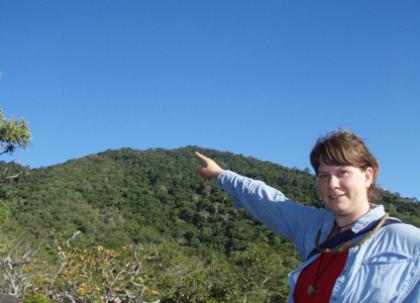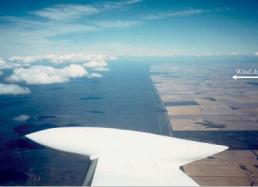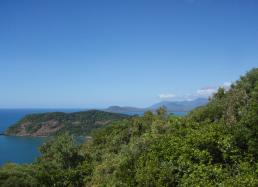4: Mount Cook and Beyond
Although the drive to Mount Cook took over eight-hours, the sights along the way varied from truly spectacular—pristine rainforests and unusual mountain formations—to just plain ugly. And by ugly, I mean it’s hard to look out across acres of sugar cane fields or banana plantations and realize that these were once lush rainforests. Now, the only surviving patches of these rich habitats perch on the mountaintops and slopes, which are too steep to plow (see Photo #1 below).
As rainforests—the “lungs” of our planet—are cleared for farmland or timber production, we're beginning to experience climate changes that have far-reaching consequences. Of course, with the disappearance of their habitat, many species of animals and plants are becoming extinct, which is a tremendous loss. And without rainforests, the water cycle and the basic exchange of oxygen and carbon dioxide in the atmosphere are being interrupted. Temperatures are rising, rainfall is diminishing, and weather patterns are de-stabilizing.
To get an amazing visual of the dramatic effect that deforestation and farming has had in parts of Australia, take a look at the aerial photo below (Photo #2) taken by meteorologist Dr. Peter Schwedtfeger. Look beyond the stark contrast of green rainforest abutting the solid line of brown farmland and notice where the cumulus clouds are forming. It’s not hard to see what’s anchoring atmospheric moisture—and who’s suffering from the lack of it.
As we headed towards Mount Cook, we had plenty of opportunities to see the long-term effects of climate shifts. We passed through great distances of arid outback habitats and lots and lots of cattle pasture land (which caused us delays on several occasion as we had to wait for roaming herds of cattle to clear off the highway.)
One of the reasons I was very interested to visit Mount Cook National Park is that it’s situated near the north end of the area recognized as the Australian Wet Tropics, and I have never collected ants this far north. I was curious to see what kind of ant diversity I’d find at this latitude and elevation. (Ant diversity patterns are often quite different from those of vertebrates in the Australian Wet Tropics. For example, while we typically find more diversity in vertebrate species at higher elevations, in invertebrate species like ants, we typically find great diversity occurs at high at both high and low elevations.)
To explain this phenomenon, let’s say you’re studying the deer population on a mountaintop. Genetically, you’d likely find that you’re dealing with only one species. The DNA would show changes between populations located on different parts of the mountain, but the deer would still be of the same species. In other words, mammal genetics don’t typically give us a very deep picture of evolutionary history.
But with ants, many different species can evolve in an incredibly small area because each species occupies a different niche—the treetops, the leaf litter, and the ground. Having so many more ant species than vertebrate species in an area allows us to detect the effects of climate change on speciation at a much deeper scale. In other words, ants give us a more detailed picture of evolutionary history.
So with this in mind, I was anxious to see what I’d find at the top of Mount Cook. After a good night’s sleep, we headed over to climb to the peak. One thing you should know about most insect biologists is that any hike will take longer than expected. We always want to stop and collect along the way, and since I need specimens for my research, stopping to collect ants on the hike is imperative.
Although it may not seem like a long way to the peak of Mount Cook from the picture of my pointing to the top, it generally takes 3-4 hours—without stopping along the way—to ascend 431 meters (1,414 feet). With all our ant collecting and a brief break to eat a peanut butter and jelly sandwich, our round trip hike took about 5 hours, instead!
Although the ant diversity was good (and I’ll be able to catalog this better once I’m back at the lab and can look at my specimens under a microscope), the ants I was most interested in were not very common at the higher elevation. But the trip was not in vain. Not only was the view from the summit spectacular (see Photo #3 below), but I did find an entire colony of Polyrhachis robsoni, one of the ant species I'm focusing on.
We'll spend several more days collecting around Mount Cook and Cooktown, then we'll head south, back into the heart of the AWT to Wooroonooran National Park (try saying that quickly three times in a row).
Off to hunt ants,
Dr. Corrie Moreau






